Ever
since the ScanSpeak SP38 construction,
large domes have had my special attention and eventually
I picked a large dome for the TQWT, DTQWT and OB9 speakers, the
venerable Audax TW034 in its latest incarnation. As
discussed numerous times, size matters and this is not
least true for tweeters. Let's look at radiating area vs.
dome diameter: 25 mm: 4.9 cm^2, 28 mm: 6.2 cm^2, 32 mm:
8.0 cm^2, 34 mm: 9.1 cm^2, 38 mm: 11.3 cm^2.
Already at 34 mm diameter we have twice the area of a
standard 1" dome. Large radiating area = reduced
excursion for same SPL = reduced distortion.
I changed the heading from "large domes" to
"large tweeter domes" as large domes might
suggest mid-domes as well, usually having a voice coil
diameter of 50+ mm. When we reach 38 mm voice coil
diameter we start having a roll-off around 15-17 kHz,
where 32-34 mm domes may well reach 20 kHz. I've already
had the suggestion of including 30 mm domes but I'll
leave out anything below 32 mm just to set a limit. The
ScanSpeak D29 range may well reach below 1 kHz, but I
never found these domes to perform well down to e.g. 1.5
kHz - for some reason.
Opponents
may argue that large domes have limited
extension and dispersion at higher frequences and the
former was quite true for the really large domes of the
past, in particular domes with 38 mm diameter like the
old ScanSpeak D3804. The current ScanSpeak D3806/8200
still doesn't do much above 15 kHz, but from the examples
shown below and in particular the Ciare MT320, we have a
frequency response that doesn't fall short of most
1" domes. And to be honest, I don't care much about
what happens above 15 kHz. There may be dips and peaks,
but as long as we don't serious resonances showing up on
the CSD plot. Main treble energy is in the 1.5-10 kHz
range and what's above 10 kHz merely adds to the
"airiness" of the reproduction.
So far it also appears some large domes have an elevated
response around ~13-16 kHz, thus an apparent decline
towards 20 kHz. Equalising the 10-20 kHz range leave at
fairly flat response from e.g. TW034 up to 20 kHz. Read
below.
So,
my current interest in large domes is based on
the Chario
Sonnet test and the unusual low point of
crossover for a 2-way. Based on sonics this goes better
than anticipated and I recently found a review of another
Chario speaker, the Academy
Sovran (Stereophile Dec. 2008), which features
the Sonnet two-way on top of a compound bass system.
Atkinson's measurements confirm the relationship and here
we have the Sonnet port stuffed to produce an aperiodic
system, most likely without a high-pass filter. The bass
section, being a double-woofer compound peaks at 40-80 Hz
and has a less than 24 dB/octave upper roll-off from the
"vented isobaric compound" enclosure as the
Chario brochure tells.
My e.g. TQWT and DTQWT constructions are based on the
idea of having an extended range driver without any
high-pass filter and as-high-as-possible point of
crossover to the tweeter, which is in contrast to
Chario's design philosophy, thus triggers my curiosity.
Any
speaker is a compromise and the Chario seems
like one of the better. The trick here is to have a point
of crossover in the 700-1400 Hz range (read why in my Sonnet review) and to
have parallel phase delays slopes in the crossover region
providing uniform off-axis performance. Why the phase
delay slopes have to be parallel and not
coincident is a bit mysterious. Why not coincident, which
would make better overall phase integration? (To make
better phase integration the bass driver would have to be
recessed some 30 mm). For whatever reason it seems to
work and the aim of this study is to try out the
principle with the Ciare MT320 and Audax TW034-modded
tweeters. The bass driver is going to be a modified Audio
Technology 6I52 driver fitted with foam surround. But
first some measurements on the Chario Sonnet dome, the
Audax TW034-modded dome, the Ciare MT320 dome and finally
the Ciare PT383 (38 mm voice coil and waveguide).
I'm
happy to have come to know the Ciare domes.
Generally they perform very well, are well constructed
and don't call for tweaks of any kind, not even changing
damping materials, which is often the case with even
expensive tweeters from e.g. SEAS. Had I known the Ciare
domes before, they might have found their way into
several of my constructions. There are two obvious
benefits from operating a point of crossover in the 1-2
kHz range: First of all not having the trouble of
creating a smooth roll-off for the midbass in the 2-5 kHz
range and secondly providing a more even power response
in the same region. The challenge of merging to the two
drivers in the 1-2 kHz range seems no more trouble than
the usual 2.5-3.5 kHz area - based on modelling. Time
will tell if reality fits modelling.
SEAS
T35C002
05-04-2013
(back to top)
I've eagerly been waiting for this large SEAS T35C002
dome. We had to wait several months in Europe compared to USA
before it was released. I never tried the alnico version, X3-06 EXOTIC
T35, finding it too
expensive and I don't belong to those who think alnico just sounds
better than anything else.
In addition to a very nice appearance this
T35C002
dome comes at a reasonable price, at least in the US, 230 USD.
From
measurements the T35C002 dome appears to perform exceptionally well. 95 dB
sensitivity, smooth frequency response from quite a range of baffles
(see below) and very low distortion up to serious levels. In short, a
dome built to be taken down to e.g. 1.5 kHz point of crossover. I'm
looking forward
to use this dome in future constructions.
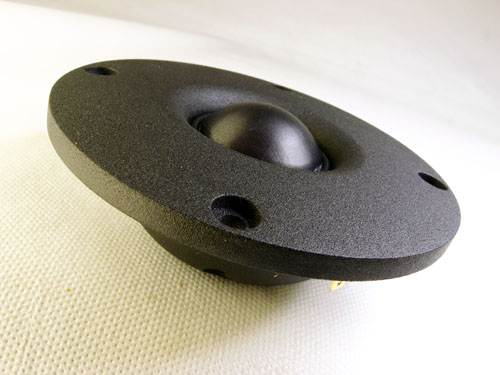
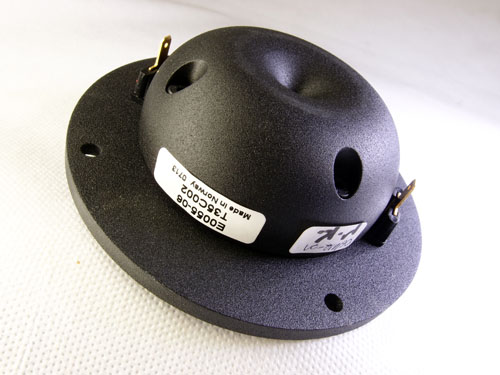
Some images can be viewed large. Click image.
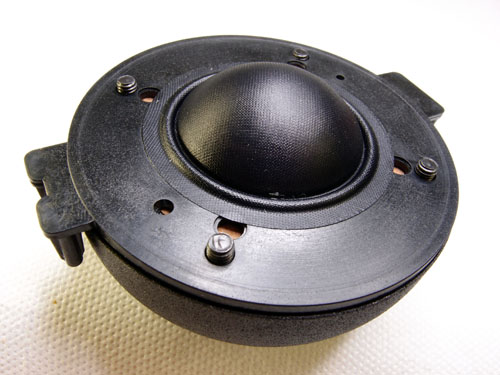
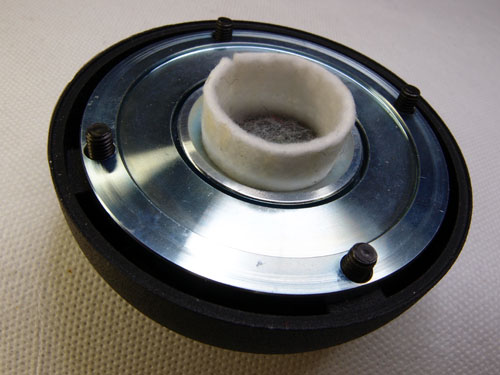
Right: Yes, this unusual cylinder of felt is what meets
the eye when we remove the dome from the magnet.
Below the felt
cylinder a thick matt of felt balancing on the interior tip of the rear
chamber.
I guess the assembly people are not happy about this
unusual arrangement, but it works well.
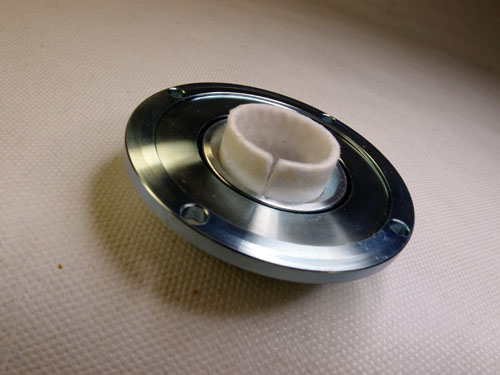
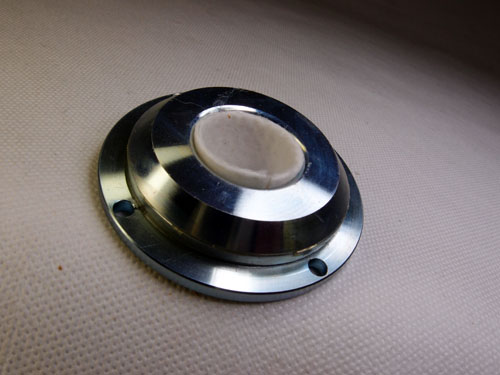
Nicely machined magnet parts holding the small
neo ring magnet. No ventilation on the outside of the voice coil, but as
suspension is very narrow, this doesn't appear to be a problem. And
large domes don't move a whole lot.
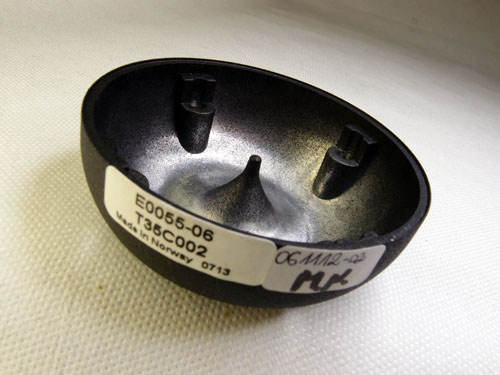
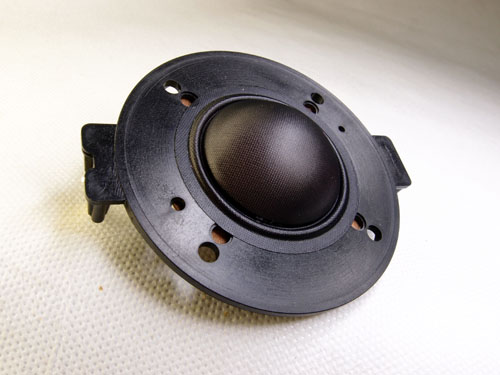
Left the rear chamber which is held in place
by four screws going into the face plate so that no screw are visible
near the dome, which always gets grumpy reviewers up the chair claiming
that it deteriorates the sound, which I don't think it does, e.g. ScanSpeak
and other SEAS domes. I've tried numerous times covering the screw holes by
tape and it doesn't do a thing whether it's there or not.
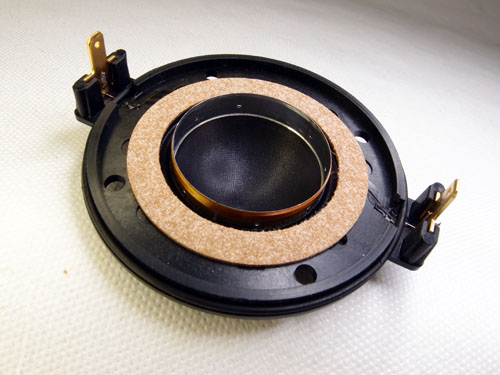
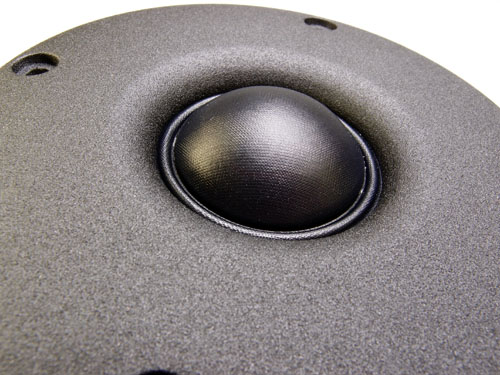
Piece of cork sealing the dome against the
magnet. Around the plastic frame holding the dome is an O-ring sealing
off the rear chamber.
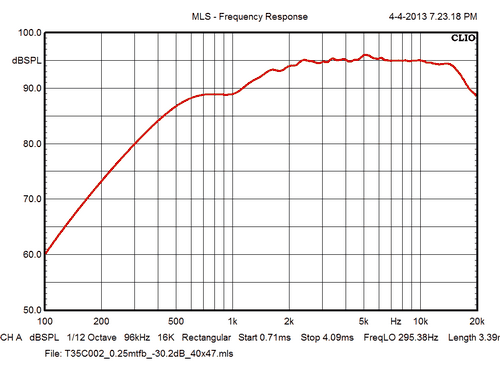
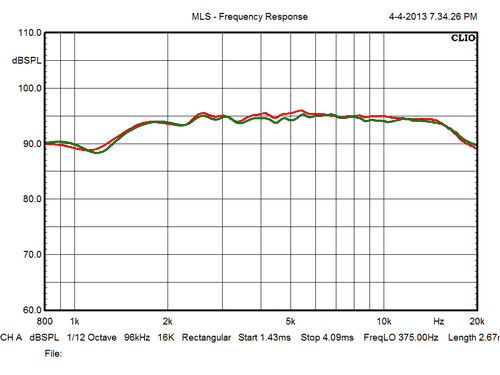
Left: Frequency response on 40 x 45 cm baffle
mounted 18 cm from top.
The dip at 900-1000 Hz is caused by the
limited baffle size compared to the SEAS measurements.
Right: Dome 1 and 2, quite a matched pair.
At around 16 kHz the dome starts declining a little, but this is no
different from e.g.
ScanSpeak Be 6640.
My measuring microphone is 1 dB down at 20
kHz.
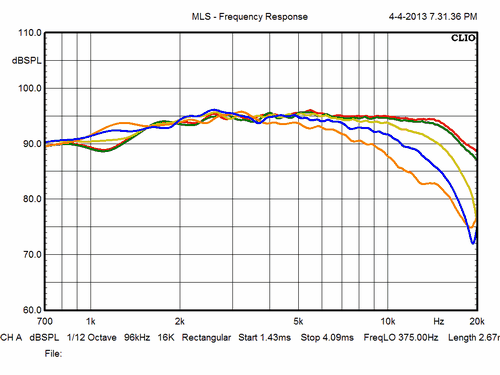
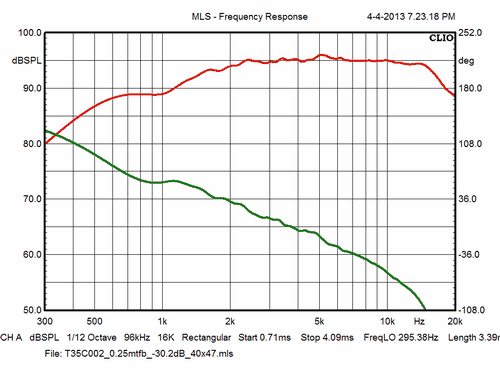
Left: Horizontal dispersion at 0, 10, 20, 30 and 40 deg.
(red/green/beige/blue/orange). Quite impressive from such a large dome.
Right: Frequency response a 1 meter/2.8V and minimum phase (green)
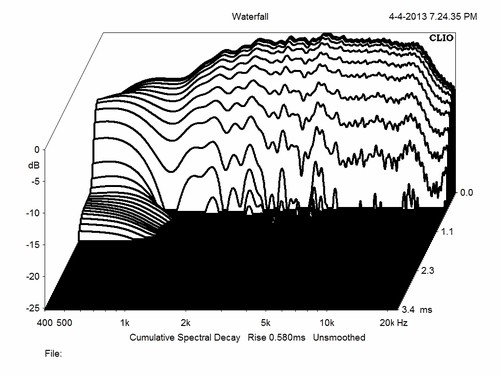
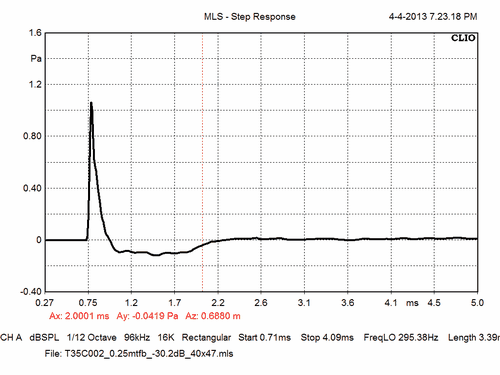
Left: CSD. This is a good as it gets, better than any of the other domes
tested here. Take notice of scaling when comparing!
Right: Step response indicates well behaved damping
material. The peak declines fast and smooth, but it takes a little time
before the dome is fully at rest. Beware of scaling when comparing to
other domes, only 5 ms shown above.
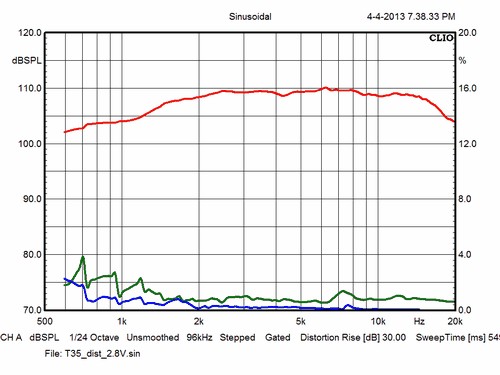
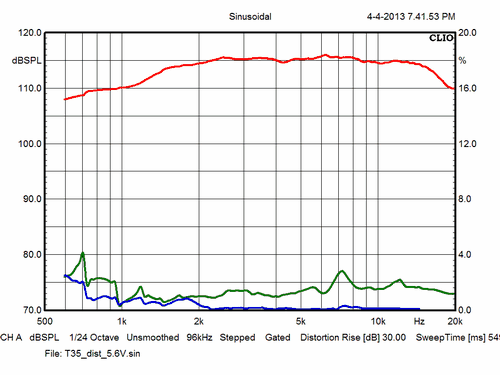
Left: Distortion at 2.8 volt input. Green = 2nd harm. Below 1% in all of
operating range. Blue = 3rd harm. Very low indeed.
Right: Same at +6
dB. This is more than 100 dB in 1 meter distance!
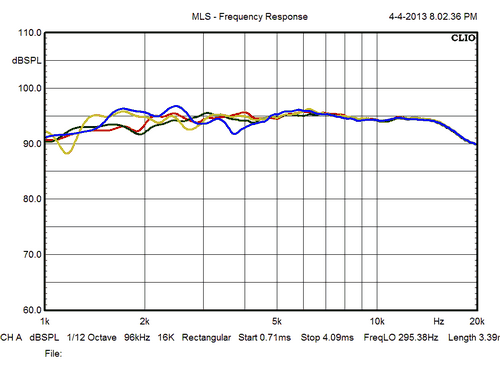
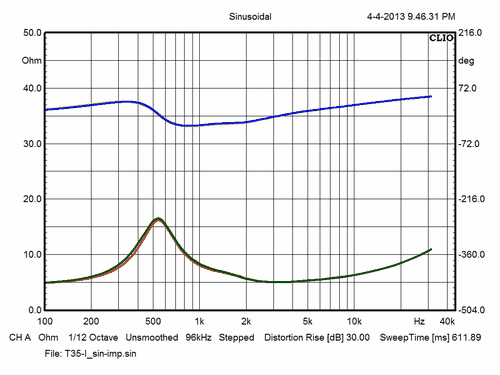
Left: Frequency response on various baffles. Now, this is not
uninteresting at all. All examples with center mounted dome.
Red: 30
cm wide baffle, 10.5 cm from center of dome to top.
Black: 25 cm wide
baffle, 10.5 cm from center of dome to top.
Beige: 20 cm wide baffle,
8 cm from center of dome to top.
Blue: 15 cm wide baffle, 7 cm from
center of dome to top.
Except for the very narrow baffle, this dome
behaves very well indeed and appears to make crossover work easy.
Right: Almost forgot: Here
are the impedance curves of both domes.
The Chario Sonnet
32 mm dome
(back to top)
From my Chario
Sonnet review I had the opportunity to take a
closer look at the quite unusual 32 mm dome tweeter.
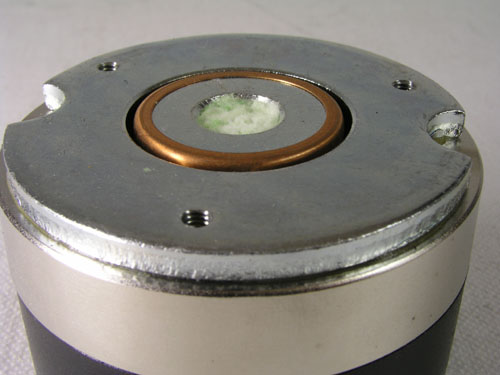 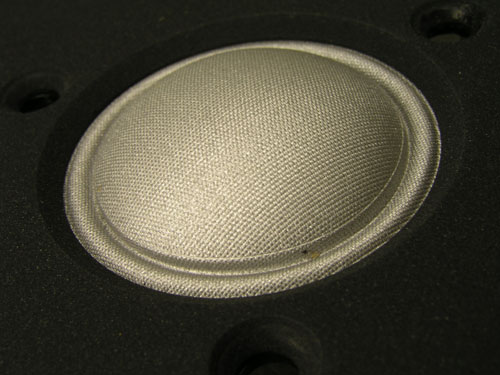
Tweeter features fabric
dome and suspension, kapton voice coil former,
vented pole piece and not least: Symmetric drive!
The copper sleeve reducing eddy currents goes all
the way to the bottom of the center pole piece
and this is the way it should be made. A copper
ring here and there doesn't quite make it. The
dome itself is special having surround and dome
made from the same fabric, actually molded from a
single piece of fabric although it doesn't look
so. The surround almost rises vertical to make a
solid connection to the voice coil former. This
may improve energy transfer from the voice coil
to the dome and enhance high frequency response.
The thin walled plastic cup making the rear
chamber is highly resonant and may benefit from a
MDF disc glued to the cup. How the interior of
the magnet cup is made and how it is damped is
not known. I expect it to be filled with the same
green glass-fiber (?) damping material that
appears to be used throughout.
|
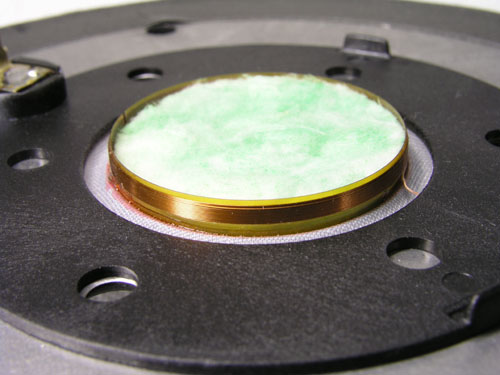 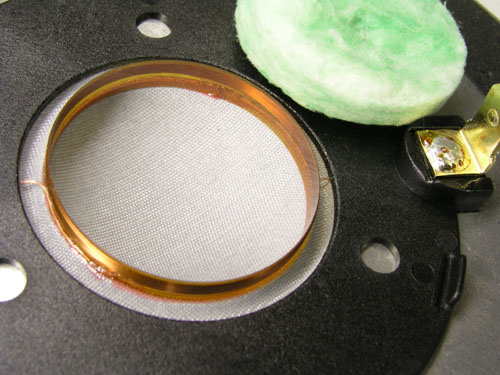
Unconventional damping of tweeter pole piece. A
large foam plug fills the dome cavity and the entire dome
is actually resting on this soft pillow.
Measurements
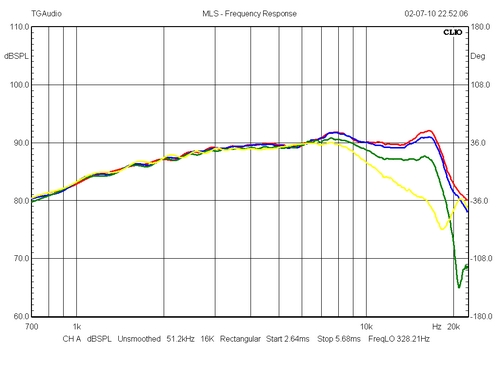 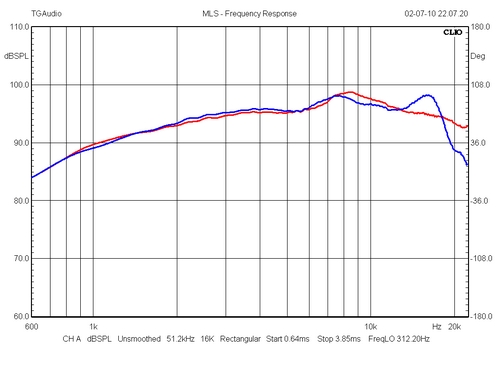
Left: Chario Sonnet tweeter @ 0, 10, 20 and 30 deg. IEC
baffle used. Right: Sonnet tweeter #1 and #2 on-axis.
As is often the case with large domes: What happens above
15-16 kHz appears quite unpredictable. My best
guess is that the type glue used for attaching the voice
coil former to the dome and the way it is done is the
main cause of variation.
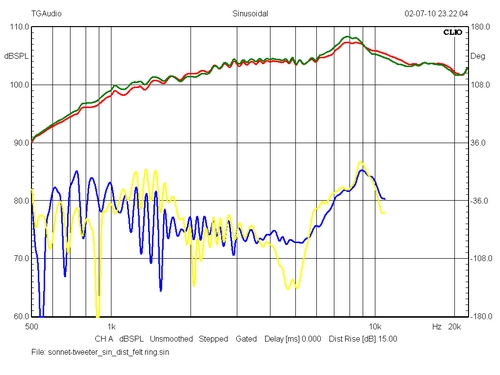 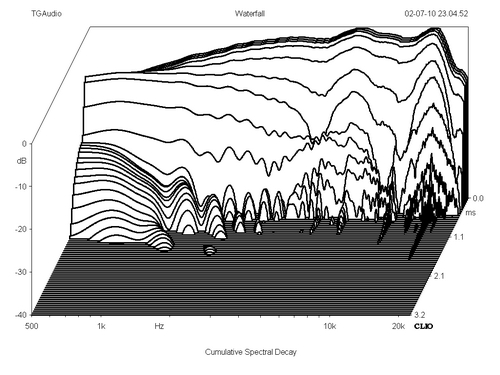
Left: Sonnet tweeter distortion with as-is damping (red
and blue) and foam plug replaced by felt ring on pole
piece (green and yellow).
Distortion measured at 0.5 meter and 2.8 volt input.
Right: Sonnet tweeter CSD/40dB scaling. This is quite an
impressive performance.
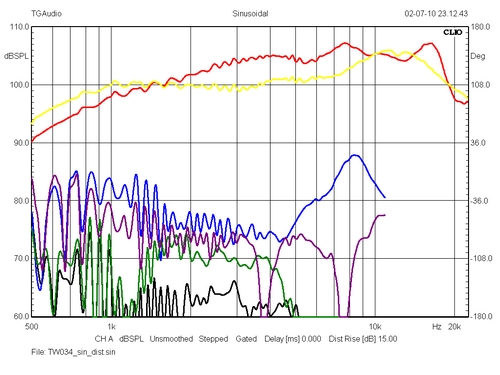
Left: Distortion: Sonnet tweeter: Red, blue, green. Audax
tweeter: Yellow, purple, black. Only 2nd and 3rd harm.
shown.
As can be seen the Chario dome peaks at 8.5 kHz where the
TW034 - for some reason - dips. I wonder why....
Distortion lines are raised 15 dB. Overall good
performance for both tweeters.
Modified Audax
TW034-XO-P47N Tweeter
(back to top)
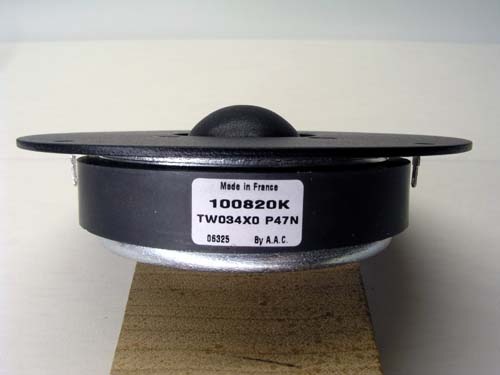 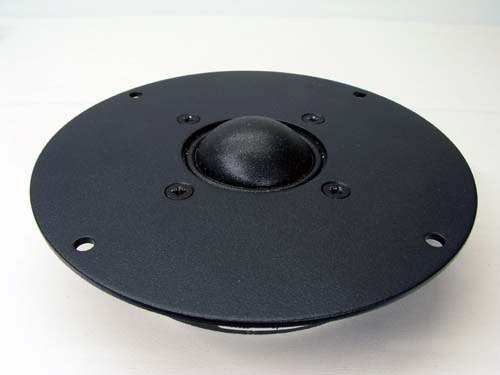
Tweeter as-is.
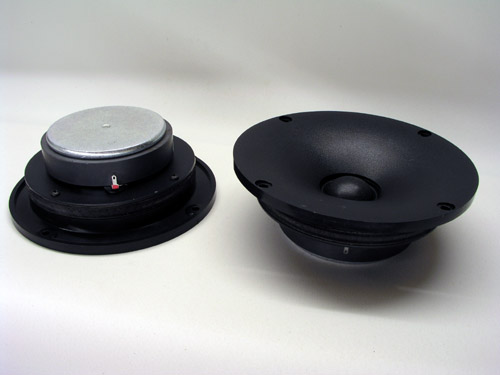 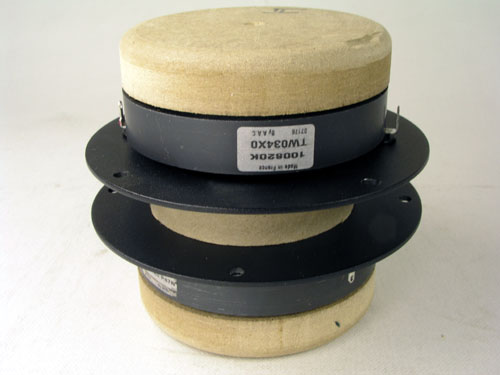
Left: TW034 with waveguide as used in TQWT and DTQWT.
Right: Modified TW034s.
With a 3rd order crossover at 3 kHz for the TQWT and
DTQWT, there is no point in modifying the dome. Have had
the question already.
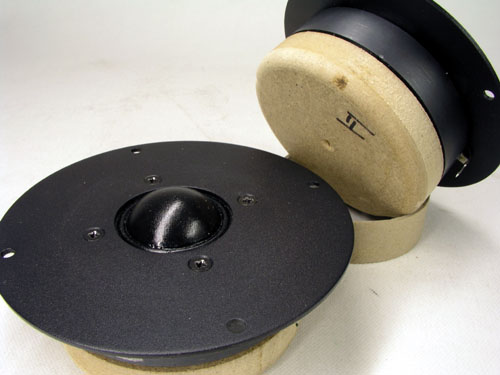 
Left: TW034 with MDF rear chamber. Right: Vented pole
piece and felt ring.
Measurements
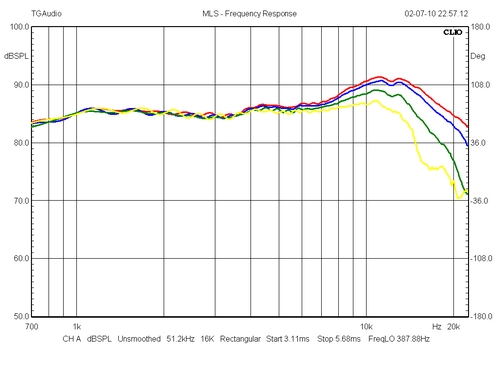 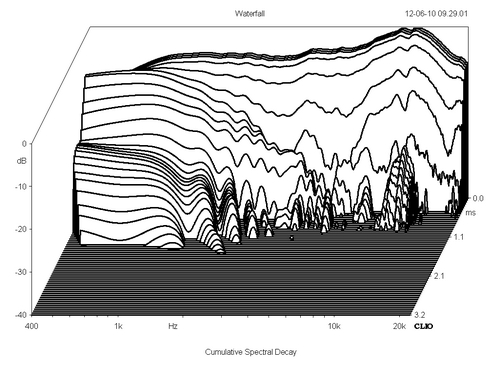
Left: TW034 SPL/2.8V @ 0, 10, 20, 30 deg. Right: TW034
CSD 40 dB scaling.
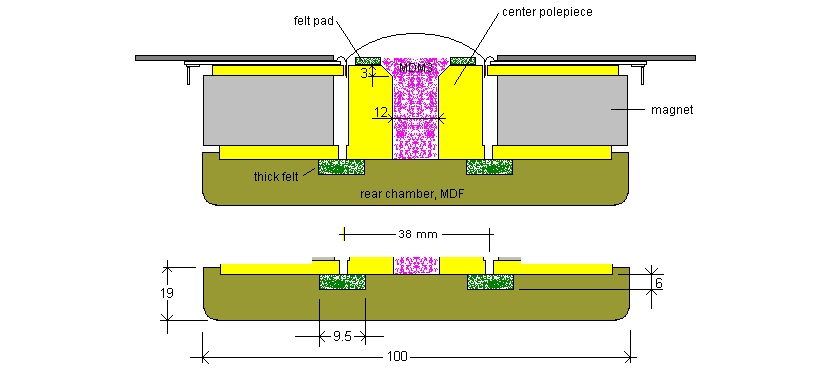
TW034 modifications. As can be seen, the vented pole
piece stops at the rear MDF plate. No further volume
needed here. It was tried and failed.
Four holes were drilled to ventilate voice coil cavity
and needs an additional volume in the MDF rear panel. A
circular ring was routed in MDF panel, 6 x 9.5 mm.
Should you want to try out these modifications, be
prepared to spend quite some time cleaning the magnet gap
for tiny iron debris. I had to make a special
0.8 mm pair of tweezers to get rid of it all. Plus a lot
of compressed air and sticky tape for final cleaning of
magnet gap. All in all quite tedious!
The full story can be read here.
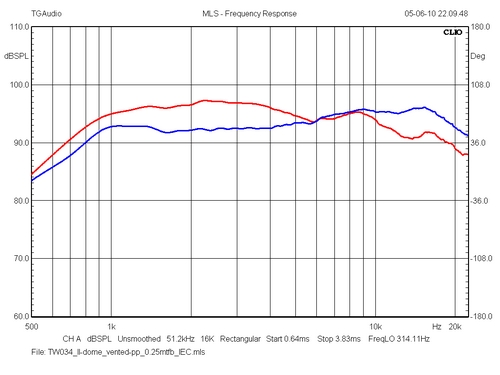 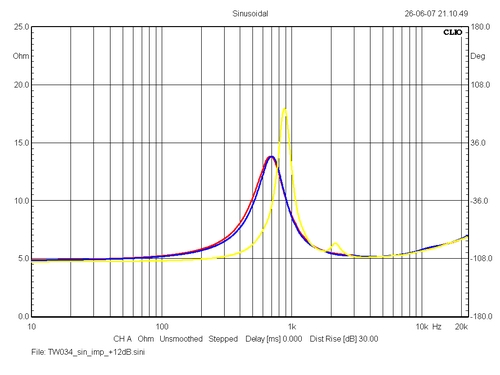
Left: Modified dome with (red) and without (blue)
waveguide on IEC baffle.
Right: TW034 impedance plots. Yellow = as-is. Red and
blue = impedance of two modified tweeters. Notch at 2.2
kHz has gone and Fs has been reduced from 900 Hz to 700
Hz.

Should we be fanatic about flat response, the
TW034-modded can be equalised this way. Not sure it pays
off.
Ciare MT320 Tweeter
(back to top)
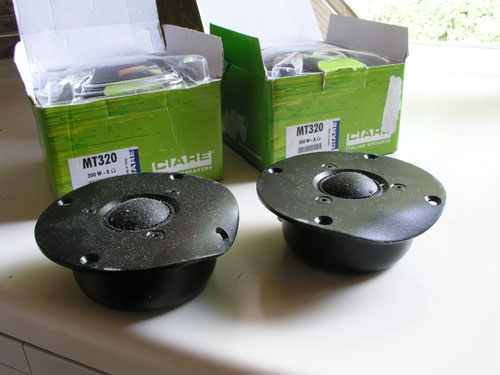 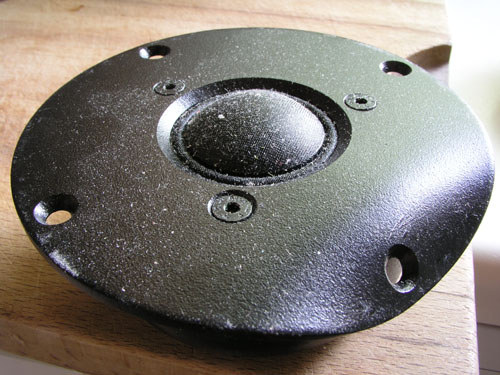
Ciare MT320 as received from www.audiosud.it.
I suggest NEVER buying from this seller. It took five
weeks before anything arrived, numerous unpleasant
emails, drivers were unbelievably dirty and both face
plates bent from improper packing.
- several hours later -
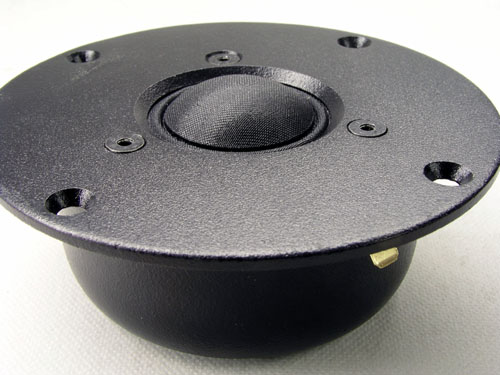 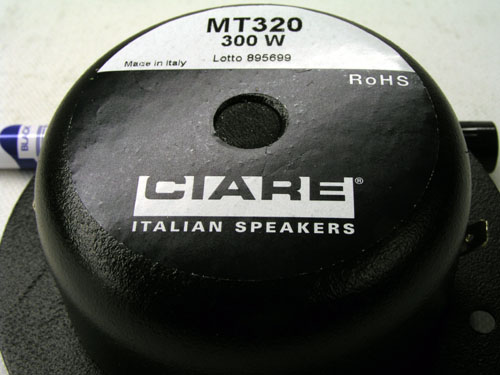
The dome was cleaned with painter's tape and face plate
was straightened in a vise. Not to perfection, but at
least flat again.
The magnetic cup shield is open to the center pole piece
vent, thus a rear chamber may be needed when placed in
the same cabinet as the bass driver.
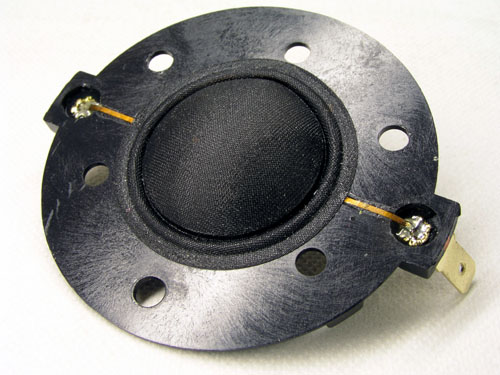 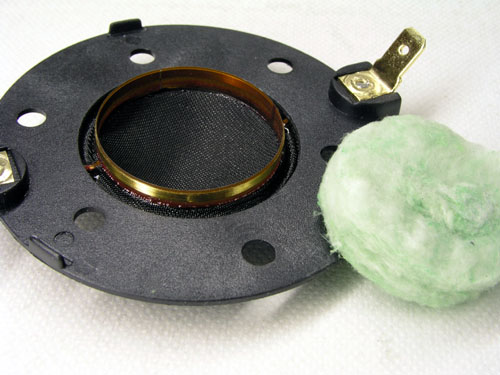
This dome is exactly the same as the Chario Sonnet dome -
except for the colour. What appears from inspecting this
dome is that is not made from separate dome and
suspension. The dome is molded in such a way it leaves a
"tube" for gluing the voice coil.
The only difference to the Sonnet dome is the termination
of the voice coil wire, here made from flat foil, where
the Sonnet dome uses the more common litze wires.
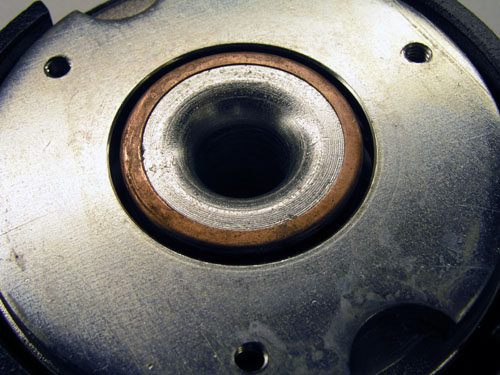 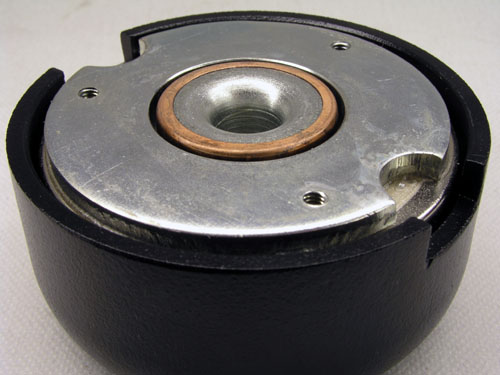
- and yes, the tweeter comes with symmetric drive! The
copper cup covering the center pole piece should reduce
magnetic stray and leaves a flat impedance profile.
This dome features a generous underhung voice coil. Upper
pole plate is no less than 5 mm thick and voice coil
windings count for approx. 2-2.5 mm, thus made for large
excursions.
Taking the MT320 domes apart tells the
story why these tweeters do not come for nothing (159
€ at Strassacker/Germany).
Generally this Ciare tweeter oozes quality - but find a
proper dealer!!
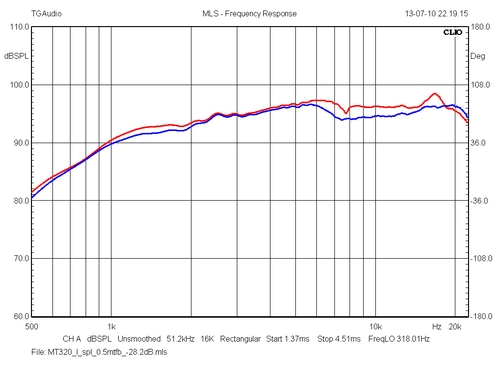 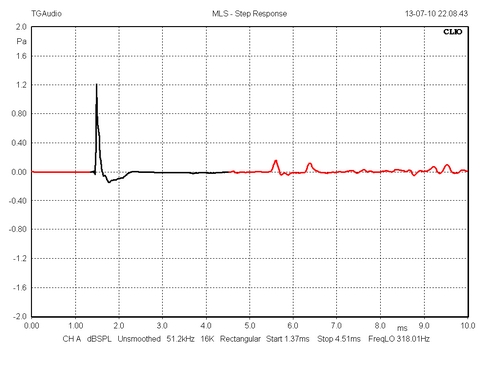
Left: SPL measured at 0.5 m distance, normalised for
2.8V/1 meter. IEC baffle used. Right: Step response.
These tweeters are indeed sensitive displaying ~96
dB/2.8V. Step response shows a very well damped system.
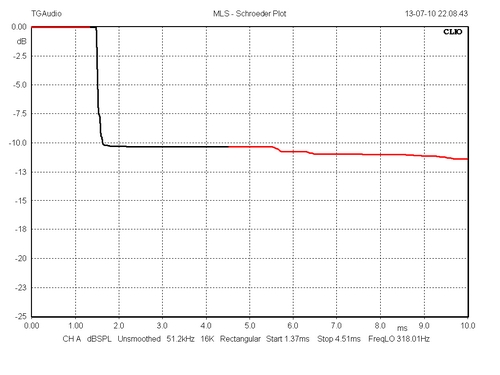 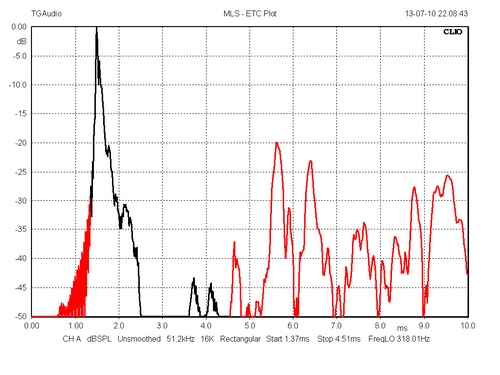
Left: Schroeder plot. Right: RTC plot.
Overall the MT320 display very little stored energy.
Excellent.
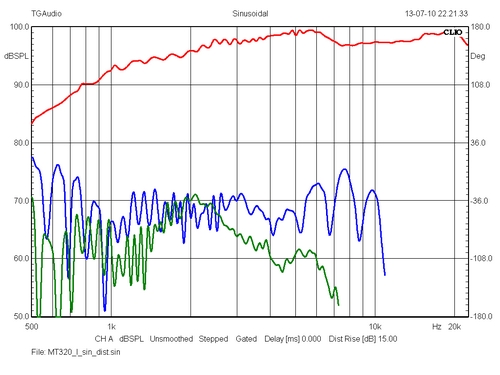 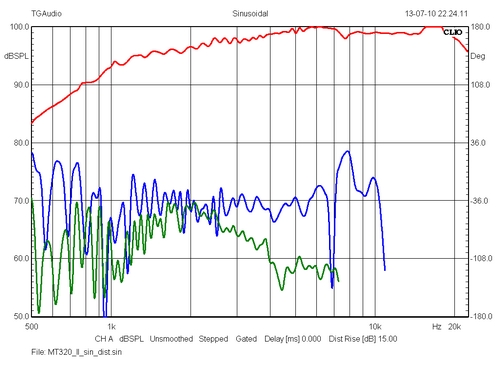
Distortion for unit 1 and 2 measured at 0.5 meter
distance. Input level corresponds to approx. 92 dB/1
meter.
An excellent performance promising a useful range down to
1 kHz.
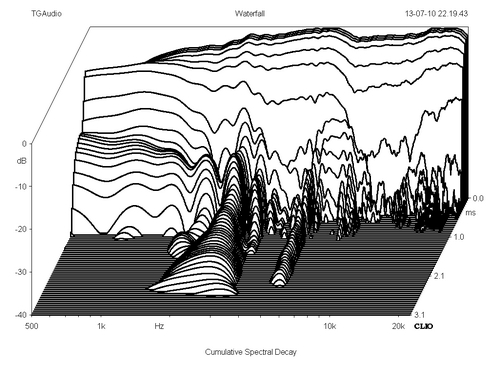 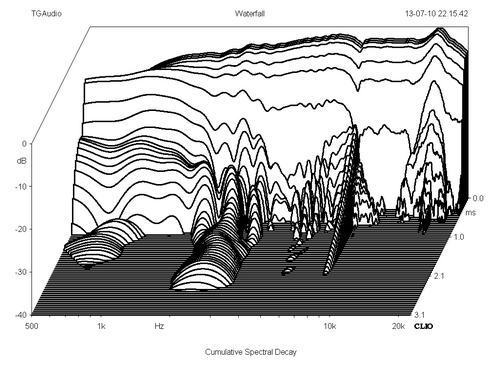
CSD for unit 1 and 2. Contrary to the Chario tweeter we
here have a minor ridge at 2500 Hz. The ridge at 7.7 kHz
for unit 2 can most likely be eliminated by rearranging
damping material.
None of the measurements above make me
rush to try out any tweaking of these tweeters.
Maybe they can be improved a little here and there, but
whether this will have any audible benefits is highly
unlikely.
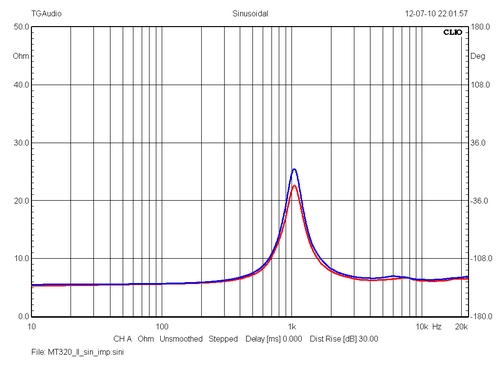 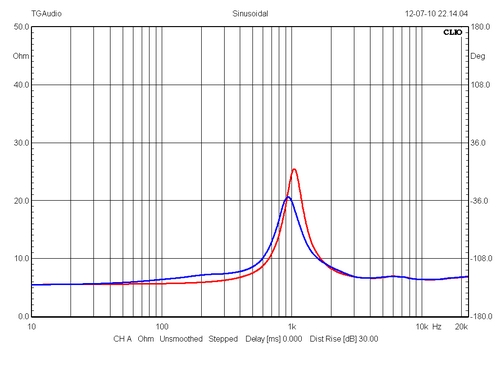
Left: MT320 unit 1 and 2. Right: Unit 2 before and after
1 min. 100 Hz "burn in" (+/- 0.5 mm cone
excursion).
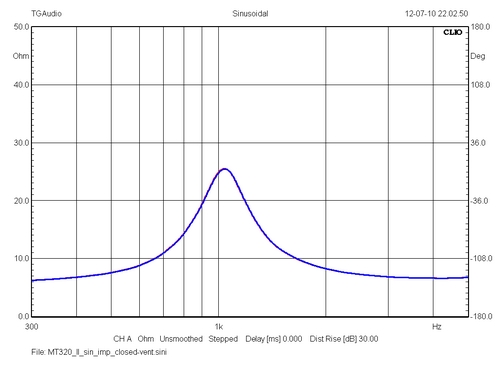 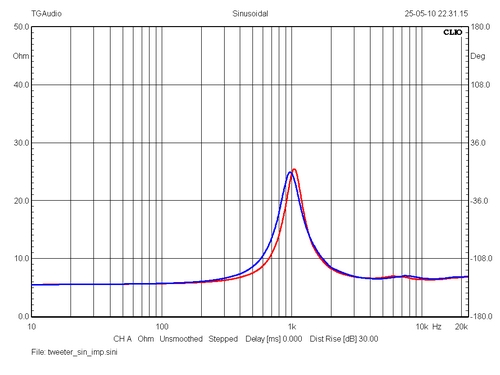
Left: MT320 with and without rear vent closed (yes, there
is a red curve behind the blue). Right: MT320 (red) vs.
Chario Sonnet tweeter (blue).
It appears the rear chamber of the Chario Sonnet tweeter
really isn't needed.
Ciare PT 383
(back to
top)
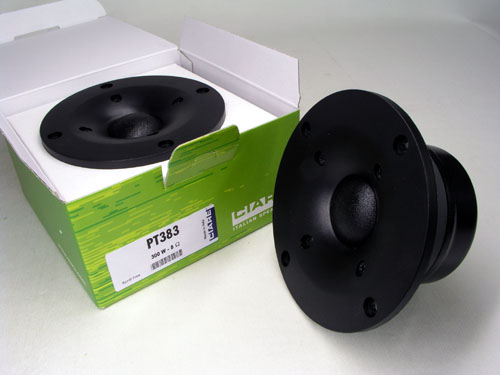 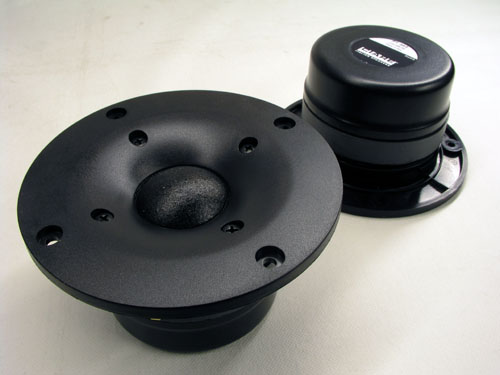
These Ciares survived shipping without damages!
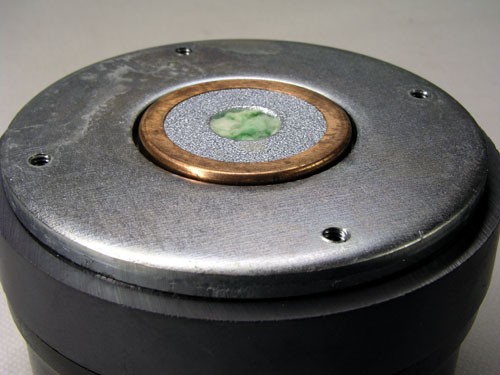 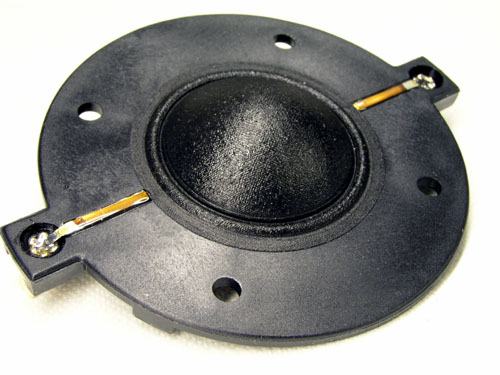
Left: SD for 62 EUR! Right: A slightly more rugged fabric
dome compared to the MT320. Like MT320 copper foil is
used for connecting voice coil wire.
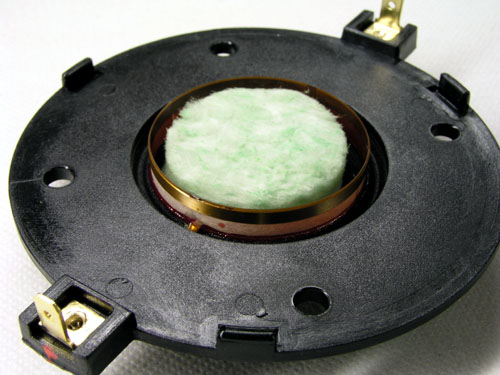 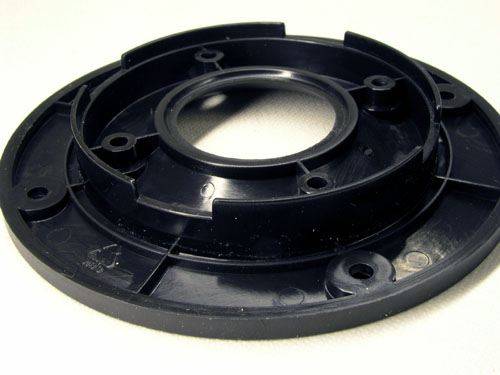
Left: Kapton voice coil former. Approx. 2.5 mm
windings in a generous 5 mm voice coil gap (depth).
Right: Waveguide made from ABS (?) plastic.
Apparently the same felt plug used for the MT320 is used
for this tweeter also. Filling the waveguide cavities
with some filler may feel good, but I'm not sure it pays
off.
OBS: The PT383 dome does not come with a
self-centering mounting plate, thus needs to be centered
by applying a
sine wave during mounting of dome + waveguide in one
operation. If you don't have measuring equipment, don't
dismantle the tweeter.
Measurements
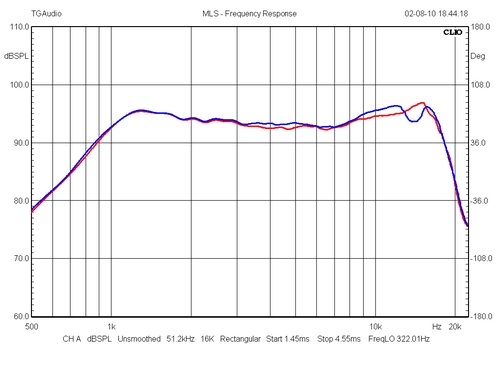 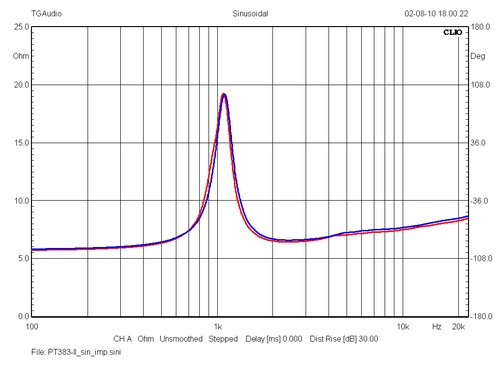
Left: SPL/2.8V/1 meter for unit 1 and 2. IEC baffle used.
Right: Impedance of two units. Fs = ~1100 Hz.
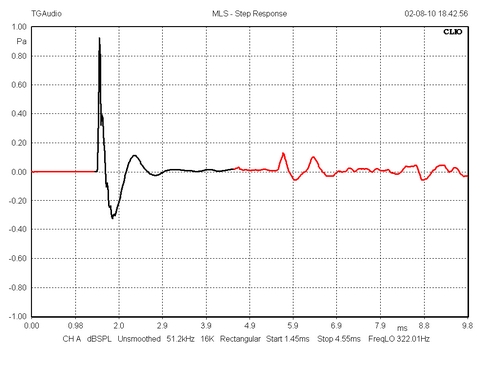 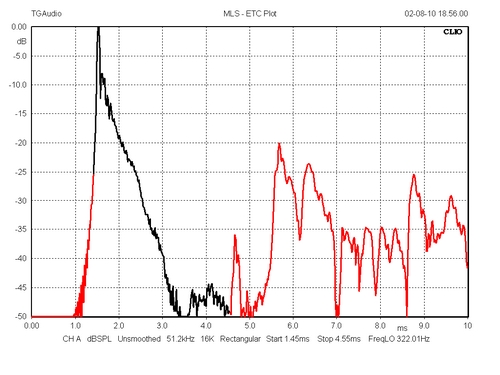
Left: Step response, unit 1. Right: ETC plot unit 1. As
can be seen, this is a larger (heavier) dome.
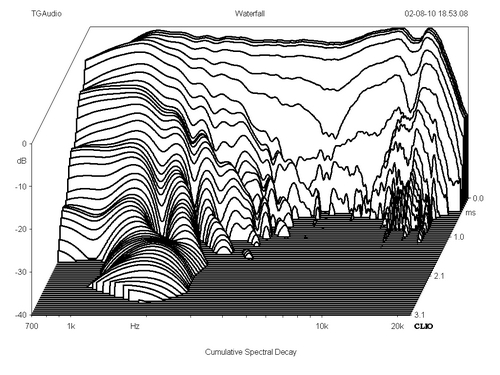 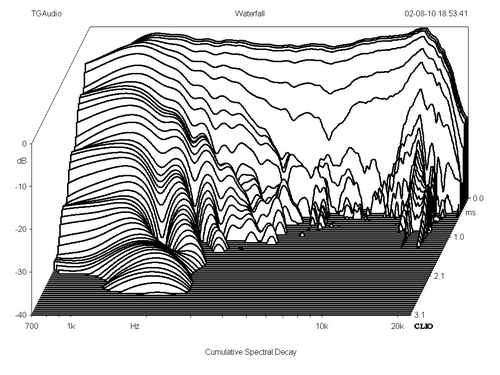
Left: CSD, 40 dB for unit 1. Right: CSD, 40 dB for unit
2.
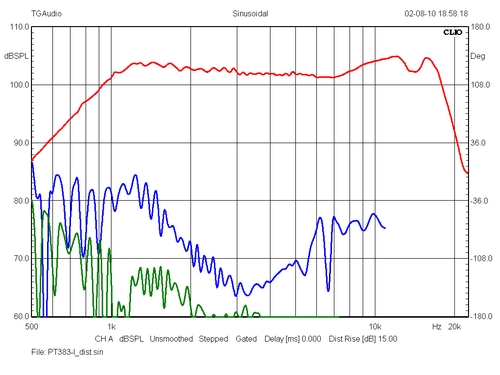 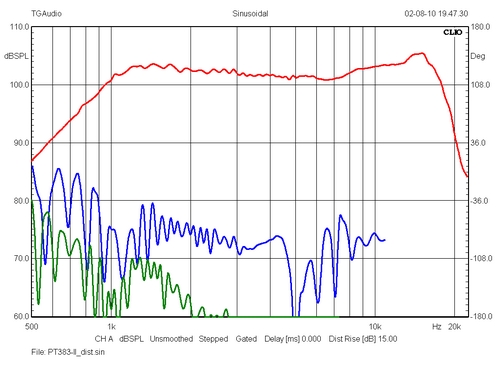
Distortion measured at ½ meter distance. Input
equivalent to 2.8V/1 meter (~95 dB).
Left-right: Unit 1 and 2. Distortion rise = 15 dB.
Overall excellent performance.
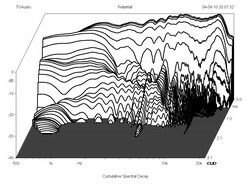 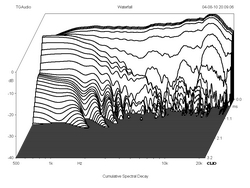 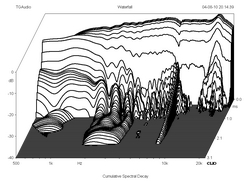 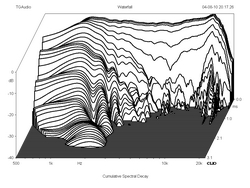
CSD, 40 dB. From left to right: Sonnet tweeter,
TW034-modded, MT320 and PT383.
Normally CSD plots are shown with a ~25 dB scale, where
the CLIO only allows 20 or 40 dB scaling. I suggest
disregarding what's below 30 dB.
All of these tweeters perform well - although I'm pleased
to see the modded TW034 perform exceptionally well.
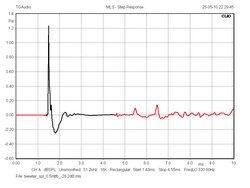 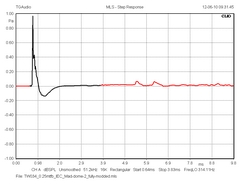 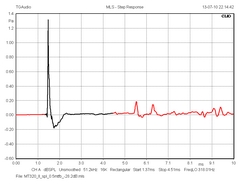 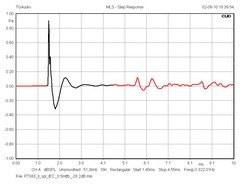
Step response: From left to right: Sonnet tweeter,
TW034-modded, MT320 and PT383. For all a 10 ms window is
used.
As can be seen the Ciare domes (1 and 3 from left) are
more efficient than the other two. The Ciare MT320
certainly is a fast and well damped dome.
Accuton
C30-6-024
(back to top)
Link
to Accuton website
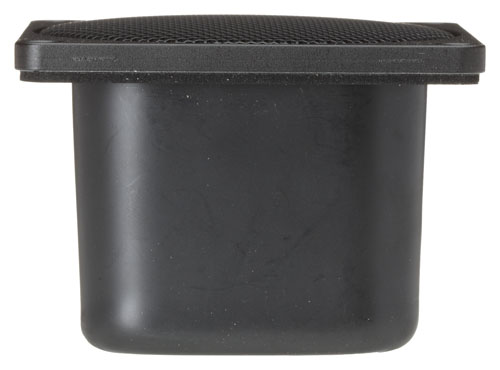
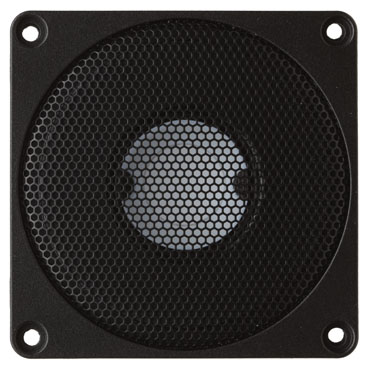
The
Accuton C30-6-024 falls between standard 1" domes and large
domes and the small 19 mm (3/4") voice coil may not cope with the same amount of
power as the domes above, but let it be. Here are my measurements.
The claimed 93 dB sensitivity may be a bit exaggerated but I won't
argue about 1 dB deviation to my measurements. Taking an average of 2-20
kHz it seems more like 91.5 dB. In the end it may all come down to
actual calibration of measuring equipment.
Listening to the MLS signal suggests a smooooth sound and I can't wait
for possible implementations.
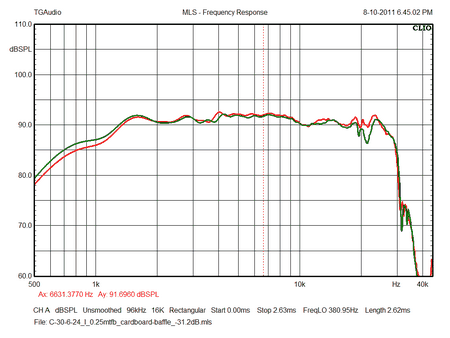
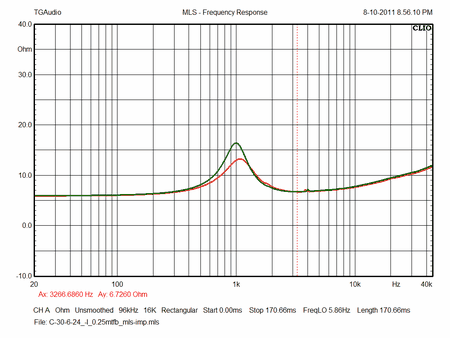
Left: SPL normalised for 1
meter/2.8 volts. Quite a mached pair and response appears to hit almost 28 kHz
before dropping rapidly.
The unrest at 20 kHz may be due to the grille.
Right: Impedance plot of the two units.
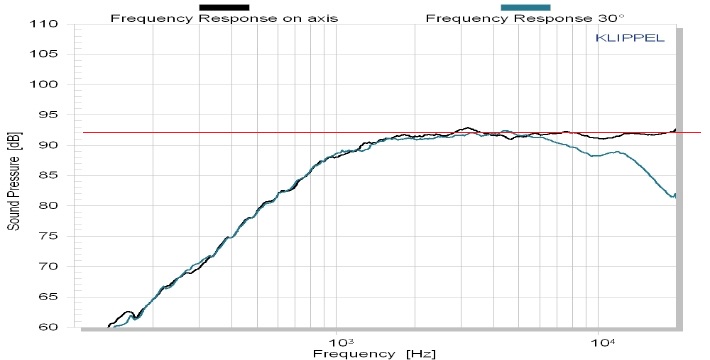
Here are Accuton's measurements.
Actually they look an awful lot like mine and more like an everage of 91.5 dB/1
meter/2.8V.
Red line added by me.
Accuton specifies tweeter sensitivities by response @ 3 kHz and as this tweeter
has a minor bump at 3 kHz, this may count for the additional 1-1.5 dB.
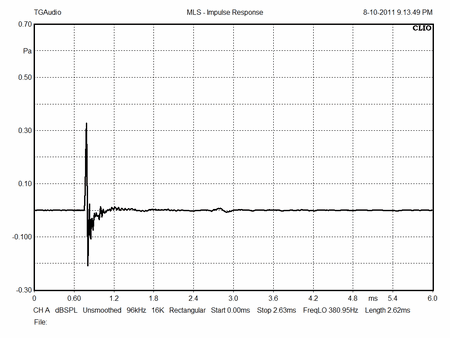
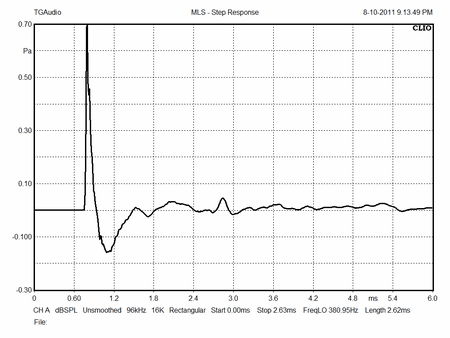
Left: Impulse response. Right:
Step response.
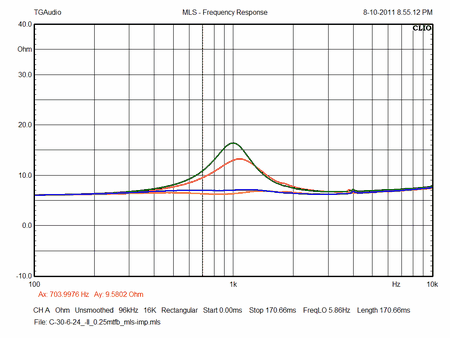
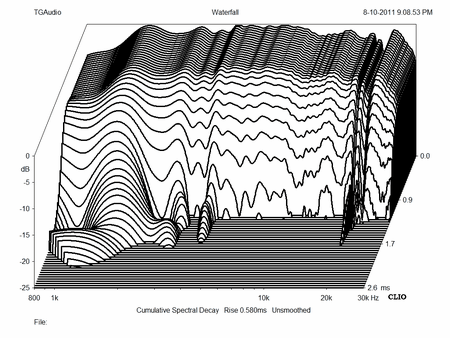
Left: Impedance can be smoothed by
15 uF + 10R + 1.75 mH, which goes for both tweeters despite differences.
Right: CSD with 25 dB scaling.
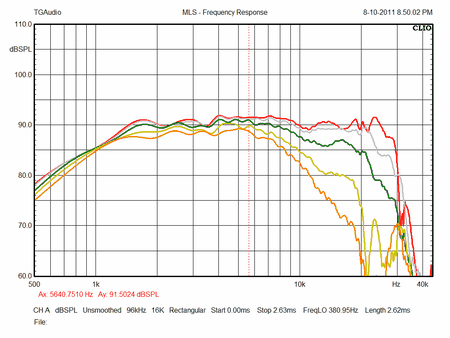
Left: Dispersion (to be repeated).
Right: Distortion: To come.
|



























































































